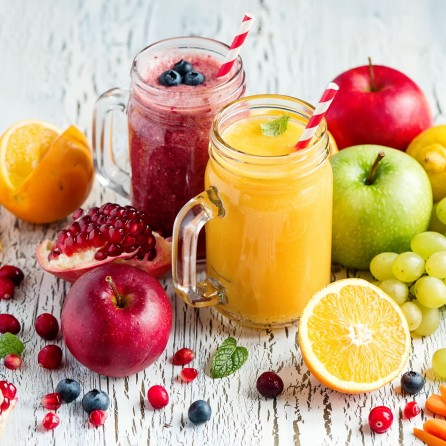
Juicing is a great way to introduce more fruit and vegetables into your diet, and aiming for seven portions a day is very beneficial for people with MS. Having a blender gives you plenty of options, and smoothies can give you an energy boost and help regulate bowel function. However, it’s important to remember that consuming fruits and vegetables whole can have higher nutritional value, and juices should be consumed alongside a balanced diet.
Juicing and smoothies can be an easy way of introducing additional fruit or vegetables into your diet with the associated vitamins, minerals and antioxidants.
All fruit and vegetables can be enjoyed freely on the Overcoming MS program. A good goal to aim for is seven portions of fruit and veg per day (two of which are fruit, five or more of which are veg). Nutritional guidance says that juice should only ever count as one portion a day, no matter how much you drink, because it doesn’t contain the fiber found in whole fruits and vegetables.
A 150 ml glass / 0.6 cup of unsweetened fruit or veg juice is equivalent to one of your daily portions.
Freshly squeezed juice is likely to retain higher vitamin and mineral levels. Many people use electric juicers to do this — you can also use a manual press, but this is usually more appropriate for citrus fruit. Alternatively, you can use a blender or a food processor to make a thicker smoothie. Juice bought in the supermarket is pasteurised (heat-processed) to kill any harmful bacteria which can have a minor reduction in nutritional value.
A good tip is to add flaxseed oil to your juice or smoothie to disguise the taste of the oil.
Juicing is not bad for you health if you have MS or more generally, but there are some things to consider:
If you are consuming fruit and veg through juicing, you are not necessarily getting the insoluble fiber benefits that you get when consuming whole fruit and vegetables which also have a higher nutritive value. This fiber feeds the friendly bacteria in your gut, can reduce or control inflammation and can help with constipation.
Sugar content in juices is often high (it can be up to 10 grams of sugar per serving) which is a large percentage of an adult’s ~30g recommended daily allowance of free sugars. You will often drink more juice than the equivalent amount of whole fruit.
This can be damaging to your teeth and is also very rapidly absorbed into the bloodstream which can cause your blood sugar to spike. One extra serving a day of juice may be associated with an increased risk of developing type 2 diabetes in women.
Fructose can cause some people to experience digestive problems particularly in those with IBS.
Make sure you consume juice alongside a balanced diet including wholefoods, protein and healthy fats.
Add vegetables to your juice, which have a lower sugar content than fruits. You could try beetroot, carrot, wheatgrass, spinach or kale.
Establish good portion control with juices — 150 ml is a recommended serving of juice. You can add water to dilute your juice and make it go further.
Try blending (smoothie) instead of juicing to retain the fiber content or making soups from vegetables.
Use frozen fruit in your smoothie to save money.
Add healthy fats, such as chopped walnuts or flaxseeds, to slow the absorption of the sugars.
Juices are extracted from fruit and vegetables without the skin, pulp and flesh.
Immunity / wellness shots are small servings of fruit juice with lots of herbs and spices in thought to boost your immune system. They often contain ingredients such as turmeric, ginger or wheatgrass which have some reported ‘immune-boosting’ properties. There is limited research about whether these are effective, but they are unlikely to do you any harm — only to your bank balance.
Smoothies are thicker drinks which often contain pureed fruits with milk, yoghurt or ice cream (dairy-free if you are making an OMS-friendly smoothie). Pureed fruits contain some of the fiber which is not found in juice. Adding dairy-free milks adds extra nutrition such as protein to your drink — useful if you are using it to replace a meal and to keep you fuller, longer.
Smoothie / acai bowls. You may have seen these beautiful creations on Instagram, smoothie bowls are thicker than a smoothie and are often served in a bowl. They are often created with frozen fruit or ice to add volume and keep them cold. They contain fruit and vegetables that have been blended along with other ingredients such as seeds, nut butters, sweeteners (such as honey) and oats. Acai bowls in particular originated in Brazil and are made with frozen acai berries which are full of antioxidants. Some people use acai berry powder for their acai bowls instead.
There is no evidence that your body needs to be detoxified by eliminating solid food. Your body is designed to remove toxins on its own, using the liver and kidneys. The effect you see from a juice cleanse is often a change to bowel function due to change in fiber and fructose in the juices. Extreme juice cleanses can cause dehydration, deplete electrolytes, and impair normal bowel function. It can also disrupt the native intestinal flora. No published research currently supports the safety or efficacy of juice cleanses or fasts.
Concentrate instead on giving your body what it needs to stay as well as possible— a balanced diet, adequate fluid intake, regular exercise and sufficient sleep.
OMS recommends consuming juice as one part of a balanced diet. Following the recommended Overcoming MS diet will ensure that you avoid many unhealthy fats (such as saturated fats and trans fats) and processed food with lots of additives.
Some people find intermittent fasting, where you have an eating pattern between eating and fasting to be beneficial for their MS symptoms.